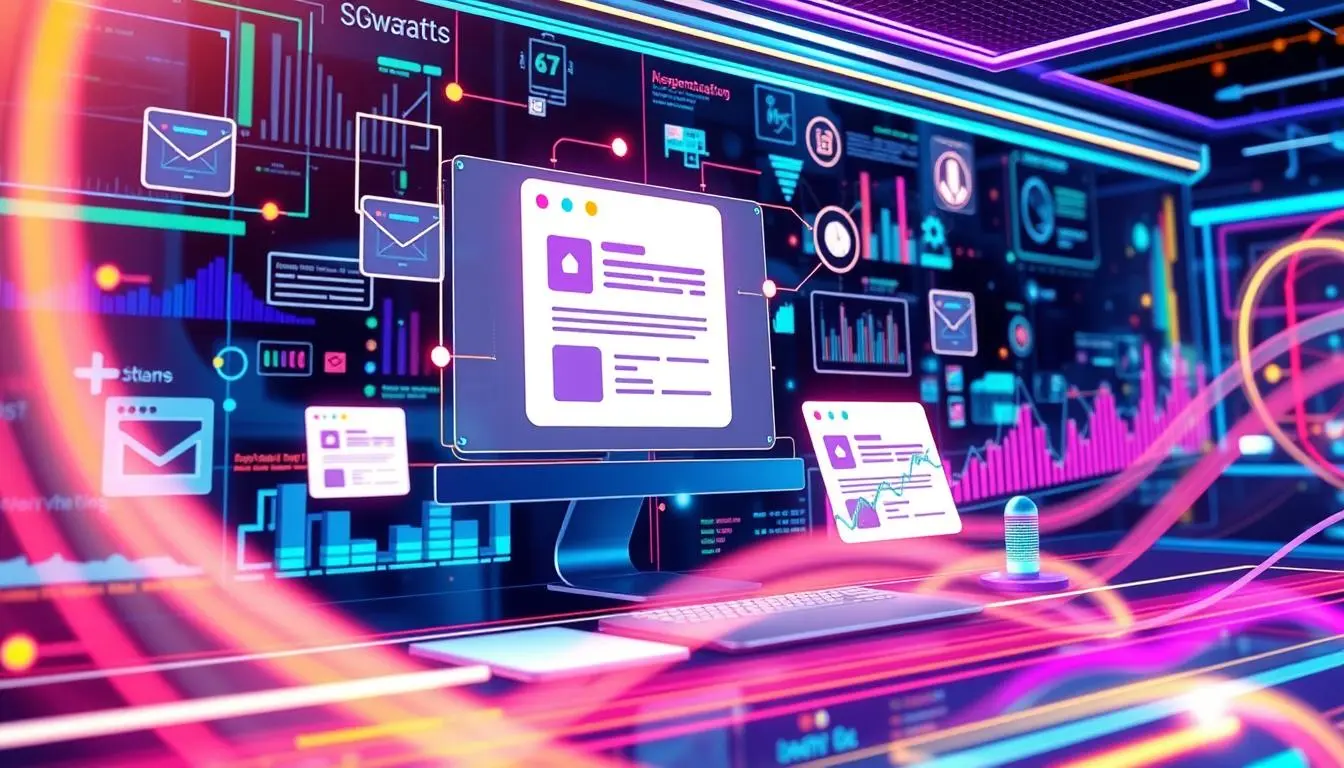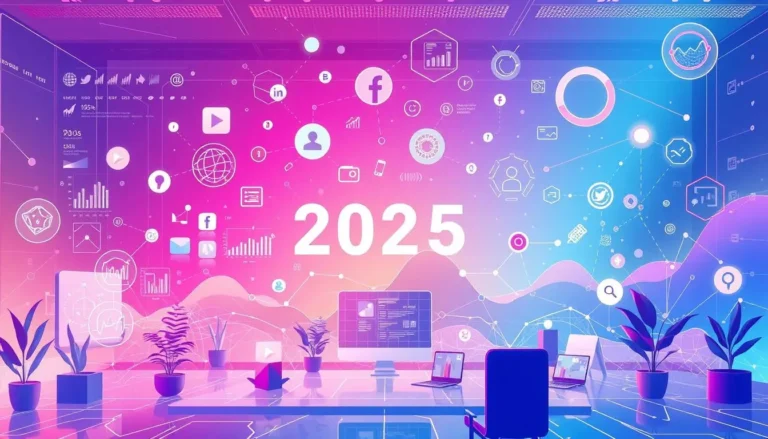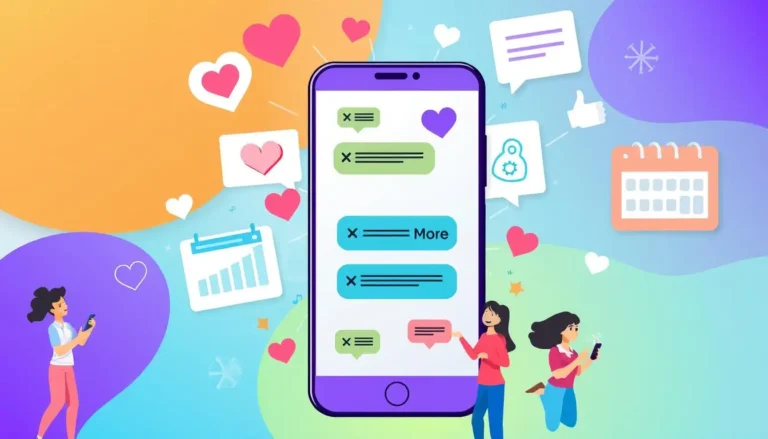Email Marketing Strategies That Will Work in 2025
Digital marketing keeps changing fast, and email marketing is key for good communication. As we get closer to 2025, businesses need to keep up with new tech and what people want. This helps them stay ahead in the digital world.
The world of email marketing is changing with new personalization, AI, and data use. Marketers who get these changes can connect better with their audience. They can also get more people involved and engaged.
Your email marketing plan should be smart, clever, and all about the customer. This article looks at the latest ways to succeed in email marketing. It helps you deal with the complex digital world.
Key Takeaways
- Embrace AI-powered personalization techniques
- Prioritize mobile-first email design
- Implement advanced segmentation strategies
- Focus on data privacy and compliance
- Integrate cross-channel marketing approaches
- Utilize interactive and rich media content
- Develop sophisticated automation workflows
The Development of Email Marketing in the Digital Era
Digital marketing has changed a lot, and email marketing is now a key way for businesses to talk to their audience. It started simple and has grown into a powerful tool for reaching out to people.
Looking back, email marketing has grown a lot. It shows how digital marketing has changed over time. Here’s how it has evolved:
- 1990s: Simple text-based newsletters
- Early 2000s: HTML design and basic segmentation
- 2010s: Mobile-responsive templates
- 2020s: AI-powered personalization
From Basic Newsletters to Advanced Automation
Email marketing has moved from simple messages to detailed, automated campaigns. Today, marketers use advanced tools to send messages that really speak to people.
“The future of email marketing focuses on sending the appropriate message to the correct individual at the perfect moment.” – Marketing Insights Report
The Impact of AI on Email Communications
Artificial intelligence has changed email marketing a lot. AI helps predict what customers want, when to send emails, and even makes hyper-personalized content.
| AI Email Marketing Capability | Impact |
| Predictive Content Recommendations | 30% increase in engagement |
| Automated Subject Line Optimization | 25% higher open rates |
| Intelligent Send Time Optimization | 40% improved click-through rates |
Current Trends Shaping Future Strategies
Good email marketing now needs a mix of tech, creativity, and knowing your customers well. As the digital world keeps changing, businesses must stay flexible and creative in how they talk to people.
Leveraging Artificial Intelligence for Personalized Campaigns
AI is changing email marketing by making it smarter and more personal. Now, your email campaigns can be tailored to fit your audience perfectly. This is thanks to advanced AI techniques.
AI in email marketing does more than just sort your contacts. It uses big data to quickly learn what your customers like and how they interact with your emails.
“AI turns generic email communications into intelligent, adaptive conversations that resonate with individual recipients.”
- Predictive content recommendations
- Dynamic subject line optimization
- Intelligent send time scheduling
- Personalized product suggestions
Email marketing pros can use AI to make emails that really speak to people. AI looks at how users interact, what they buy, and what they do in real time. This lets you customize emails like never before.
| AI Personalization Technique | Customer Impact |
| Behavioral Analysis | 90% increased engagement |
| Predictive Content | 70% higher conversion rates |
| Dynamic Segmentation | 85% improved relevance |
Adding AI to your email marketing can make a big difference. AI tools keep learning and getting better at understanding what your audience wants.
Advanced Segmentation Techniques for Better Targeting
Email marketing has changed a lot. It’s now about targeting the right people with the right content. Advanced segmentation helps you group your audience in meaningful ways.
Understanding your audience is key to good email marketing. Advanced segmentation lets you connect with your subscribers on a deeper level.
Behavioral Segmentation Methods
Behavioral segmentation looks at how people interact with your emails. It includes:
- Tracking email engagement rates
- Monitoring website interactions
- Analyzing click-through patterns
- Identifying inactive subscribers
Demographic and Psychographic Profiling
Today’s email marketing needs a detailed look at your audience. Psychographic segmentation explores what drives your subscribers.
“The more you know about your audience, the more effectively you can communicate.” – Marketing Insights
Purchase History-Based Segmentation
Looking at what your customers buy can give you great insights. You can:
- Create targeted product recommendations
- Design personalized discount strategies
- Develop loyalty program communications
- Predict future purchasing behavior
These advanced techniques turn email marketing into a powerful tool. It’s now about engaging and converting customers.
Interactive Email Content and Rich Media Integration
Email marketing has changed a lot. Now, it’s all about interactive content. Your inbox is not just for text anymore. It’s a place for fun and engaging experiences.
Today’s email marketing uses the latest tech to create amazing experiences. Interactive content turns simple emails into exciting moments. These moments grab attention and get people to take action.
- Embedded product carousels that users can swipe directly in the email
- Interactive surveys and quizzes for instant feedback
- Clickable image galleries showcasing multiple products
- Video previews that play within the email interface
The key to successful interactive content is seamless user experience. Your email should be easy to use. It should let users interact without leaving their inbox. This makes people more engaged and gives you useful feedback.
“Interactive emails are not just messages; they’re experiences that invite participation.” – Digital Marketing Insights
Adding cool stuff like GIFs and animated graphics makes your emails pop. You want each email to be a special moment for your audience.
The future of email marketing is all about making it personal and interactive. As tech gets better, we’ll see even more ways to connect with people through email.
Email Marketing Automation and Workflow Optimization
Modern email marketing uses advanced strategies that go beyond simple messages. Automation workflows change how businesses talk to their audience. They make interactions personal and timely, boosting engagement and sales.
For email marketing automation to work, you need a smart plan. It should guess what customers need and send them the right content at the best time.
Trigger-Based Email Sequences
Smart email marketing uses trigger-based sequences for dynamic messages. These automated paths react to what users do, sending them messages that fit their needs.
- Welcome series for new subscribers
- Abandoned cart reminders
- Post-purchase follow-up emails
- Re-engagement campaigns for inactive users
Customer Journey Mapping
Knowing your customer’s path is key for good automation workflows. By watching how they interact, you can send emails that really speak to them.
| Journey Stage | Automation Strategy | Key Objective |
| Awareness | Educational content series | Build initial interest |
| Consideration | Comparison and value-driven emails | Highlight product benefits |
| Decision | Targeted conversion emails | Encourage purchase |
Performance Tracking and Analytics
Good analytics are essential for email marketing automation. By watching important metrics, you can make your workflows better and boost engagement.
“Data-driven decisions transform good email marketing into exceptional customer experiences.” – Marketing Insights Report
Watch open rates, click-through rates, conversion rates, and how many subscribers you get. These numbers help you make your email campaigns more effective.
Mobile-First Email Design Strategies
Email marketing has changed with the rise of smartphones. Your emails need to look great on small screens and be fun to use. Now, over 60% of emails are opened on mobile devices, making it key to design for mobile first.
“Design for mobile first, desktop second” – Mobile Marketing Experts
Creating emails that work well on mobile takes careful planning. Here are some important tips for mobile-friendly emails:
- Responsive layout that adjusts to different screen sizes
- Simplified, thumb-friendly navigation
- Large, tappable call-to-action buttons
- Minimal, lightweight graphics
- Readable fonts without zooming
For mobile-first email marketing, keep these technical tips in mind:
| Design Element | Mobile Optimization Strategy |
| Screen Size | Use responsive HTML and CSS media queries |
| Load Time | Compress images, minimize code |
| Button Size | Minimum 44×44 pixels for easy tapping |
| Font | 16px minimum, sans-serif typefaces |
By focusing on mobile-first design, you make your emails more accessible and engaging. This way, you connect better with today’s mobile-focused audience.
Privacy Compliance and Data Protection in Email Marketing
Email marketing is changing fast, with privacy being a big deal for everyone. It’s important to find a balance between sharing info and keeping it safe.
For email marketing pros, keeping data private is key to keeping customers happy and avoiding legal trouble. The rules around data are getting stricter, so paying close attention is a must.
GDPR and CCPA Compliance Guidelines
Knowing the rules is essential for good email marketing. The GDPR and CCPA give us important guidelines for protecting data:
- Get clear consent before collecting data
- Make it easy for people to opt out
- Keep user data safe with strong security
- Be open about how you use data
Data Collection Best Practices
Collecting data the right way helps you earn trust in your email marketing. Here are some key tips:
- Only get the data you really need
- Use safe ways to store data
- Keep your privacy policies up to date
- Use methods to keep data use down
Building Trust Through Transparency
Building trust with your audience is key to good email marketing. Be transparent regarding your management of personal data. Let users know how you use their info and give them control over it.
Cross-Channel Integration and Omnichannel Approach
Your email marketing strategy can’t stand alone. The best digital marketing plans use an omnichannel strategy. This connects many communication platforms smoothly. It makes a single customer experience that boosts engagement and sales.
“The future of marketing is not about single-channel communication, but creating a holistic, interconnected approach.” – Digital Marketing Experts
To make an effective omnichannel strategy, you need careful planning. Here are some key points for successful cross-channel integration:
- Consistent brand messaging across all platforms
- Synchronized data collection and tracking
- Personalized customer journey mapping
- Real-time communication synchronization
Email marketing is a key part of your omnichannel plan. By linking email campaigns with social media, SMS, and push notifications, you build a strong marketing system. Data from different touchpoints helps make your email content more targeted and personal.
Your aim is to give customers a smooth experience across different platforms. This means your message, design, and core values should be the same everywhere. Whether it’s an email, your website, or social media, the experience should be consistent.
“Integration is not about technology, but about creating a unified customer experience.” – Marketing Innovation Quarterly
To get the most from your omnichannel strategy, use advanced analytics tools. These tools track customer interactions across various channels. This data helps you improve your email marketing and connect better with your audience.
Measuring ROI and Key Performance Metrics
Understanding your email marketing’s true value needs a smart approach to measuring performance. ROI measurement looks beyond simple numbers. It dives deep into metrics that show your campaign’s real impact.
Good email marketing needs a full view of key performance indicators (KPIs). These KPIs give you insights into how well your campaigns work.
Essential Email Marketing KPIs to Track
- Open rates
- Click-through rates (CTR)
- Conversion rates
- Email list growth
- Unsubscribe rates
Advanced Analytics Tools for Deeper Insights
Today’s email marketing needs advanced analytics tools. These tools turn raw data into strategic insights. Google Analytics and specialized email marketing software are great for this.
| Metric | Benchmark | Optimization Strategy |
| Open Rate | 15-25% | Improve subject lines |
| Click-Through Rate | 2-5% | Personalize content |
| Conversion Rate | 1-5% | Refine call-to-action |
Performance Optimization Strategies
Your email marketing ROI should always be getting better. Use A/B testing, segment your audience, and check your data often. This will help you improve your strategy.
“Data is the new oil of digital marketing. Understand it, refine it, and it will drive your success.” – Marketing Insights Report
By using these ROI measurement methods, you’ll make your email marketing a key part of your revenue strategy.
Conclusion
As digital communication keeps changing, your email marketing plans for 2025 need to keep up. The world of email marketing is moving fast. It’s driven by new tech, like artificial intelligence, and a focus on making things personal and user-friendly.
To succeed in email marketing in 2025, you must use new tech like AI and interactive content. You also need to care about keeping user data safe. Brands that use these tools will stand out. They’ll send messages that really connect with their audience.
The main thing is to be flexible and always learning. Email marketing plans for 2025 are not set in stone. They need to change as new tech comes along and as your audience’s needs shift. By keeping up with tech and knowing what your audience wants, you can make emails that really get people’s attention.
Starting your path to email marketing success means using these new strategies. Get the best tools, focus on keeping user data safe, and be ready to change your plans. The future of email marketing is for those who mix tech, creativity, and smart planning.







